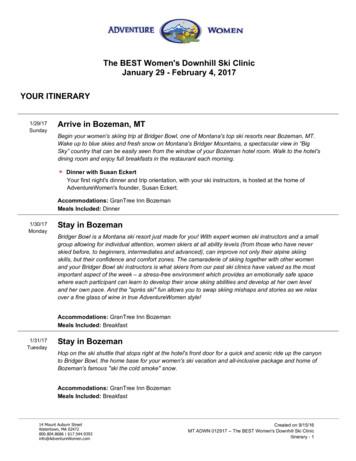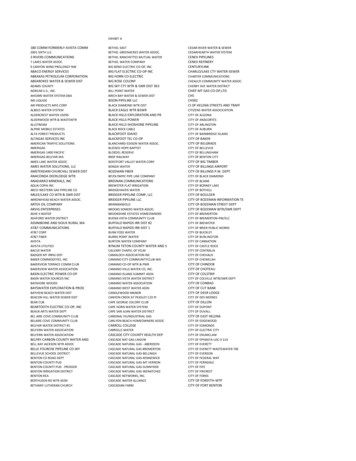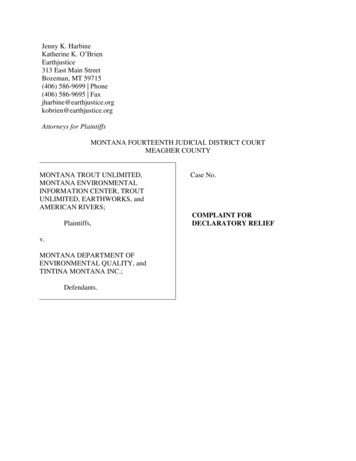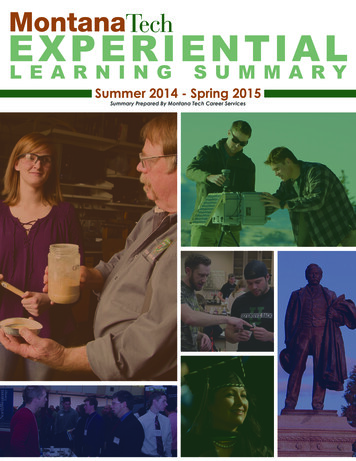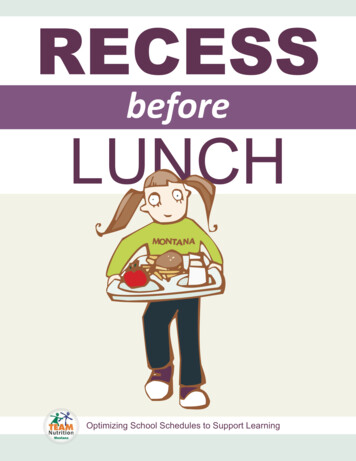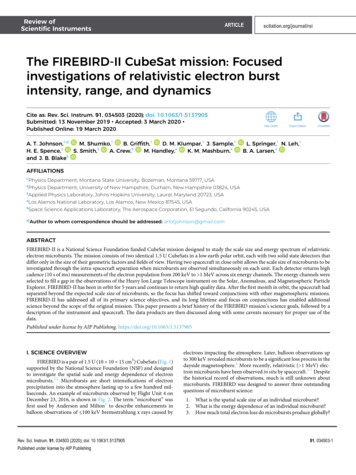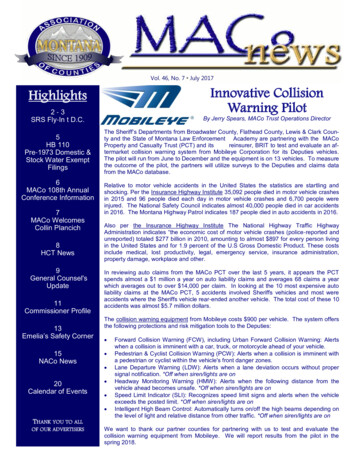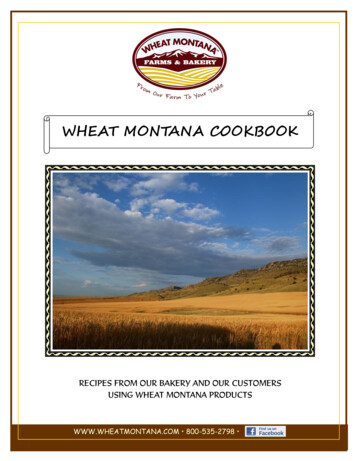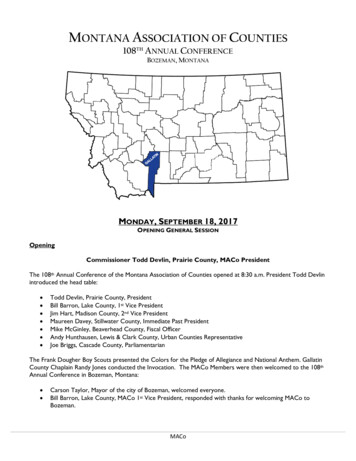
Transcription
MONTANA ASSOCIATION OF COUNTIES108TH ANNUAL CONFERENCEBOZEMAN, MONTANAMONDAY, SEPTEMBER 18, 2017OPENING GENERAL SESSIONOpeningCommissioner Todd Devlin, Prairie County, MACo PresidentThe 108th Annual Conference of the Montana Association of Counties opened at 8:30 a.m. President Todd Devlinintroduced the head table: Todd Devlin, Prairie County, PresidentBill Barron, Lake County, 1st Vice PresidentJim Hart, Madison County, 2nd Vice PresidentMaureen Davey, Stillwater County, Immediate Past PresidentMike McGinley, Beaverhead County, Fiscal OfficerAndy Hunthausen, Lewis & Clark County, Urban Counties RepresentativeJoe Briggs, Cascade County, ParliamentarianThe Frank Dougher Boy Scouts presented the Colors for the Pledge of Allegiance and National Anthem. GallatinCounty Chaplain Randy Jones conducted the Invocation. The MACo Members were then welcomed to the 108thAnnual Conference in Bozeman, Montana: Carson Taylor, Mayor of the city of Bozeman, welcomed everyone.Bill Barron, Lake County, MACo 1st Vice President, responded with thanks for welcoming MACo toBozeman.MACo
Page 2Roll CallCommissioner Mike McGinley, Beaverhead County, MACo Fiscal OfficerAfter Roll call was taken, Commissioner McGinley announced a quorum was present to conduct business (see rollcall attachment, page 40, for members present).Approval of the 2016 Minutes – 107th Annual ConferenceMotion/Vote: John Ostlund, Yellowstone County, made a motion to approve the 2016 Annual Conferenceminutes. The motion was seconded by Keith Holmlund, Custer County. The motion passed unanimously.Resolution in MemoriamCommissioner Don Seifert, Gallatin CountyWhereas, the members of the Montana Association of Counties, with great sorrow and a deep sense of loss, wishto remember and honor those members who have been taken by death since the last Annual Conference of ourAssociation; andWhereas, each of those County Commissioners has rendered innumerable public services to his or her respectivecounty, to the state of Montana, and to the people thereof; andWhereas, the absence of these persons is keenly felt as a great personal loss to their families, friends, andcolleagues.Now, therefore, be it resolved, by the Montana Association of Counties in conference duly assembled inBozeman, Montana, this 18th day of September 2017, that the Association does hereby pay tribute to the memoryof Commissioners: Robert McComb, Mineral CountyDan Gutebier, Park CountyGarth Haugland, Beaverhead CountyDennis Henderson, Butte-Silver Bow CountyAntoinette “Toni” Hagener, Hill CountyFrank Cole Jr., Carbon CountyLee Chapman, Prairie CountyRobert Friedrich, Sheridan CountyBernt Ward, Sheridan CountyOlaf Thomas “Tom” Pugrud, Petroleum CountyJohn Grewell, Carbon CountyDuane Mathison, Custer CountyAnd on behalf of its members and the citizens of theState of Montana, the Montana Association of Countiesdoes hereby express gratitude for their achievementsand contributions to the public good of their countiesand to Montana.The assembly was asked if there were additional names to be added to the Memorial Resolution. DuaneMathison, Custer County was added to the memorial resolution.MACo
Page 3Motion/Vote: Commissioner Herb Townsend, Meagher County, made a motion to adopt the MemorialResolution. The motion was seconded by Commissioner Jerry Collins, Garfield County. The motion passedunanimously.AnnouncementsCommissioner Todd Devlin, Prairie County, MACo President American Hero Quilting ProjectTurn in commissioner bio sheets for committee appointments; this information also helps put togetherthe MACo Directory.Visit with exhibitors and get your sheet signed.Raffle for PicturesNominations Committee ReportCommissioner Todd Devlin, Prairie County, MACo PresidentThe Board of Directors, acting as the Nominations Committee, brings forth the candidates for the 2017 year asfollows: Office of Immediate Past President: Todd Devlin, Prairie CountyOffice of President: Bill Barron, Lake CountyOffice of 1st Vice President: Jim Hart, MadisonCountyOffice of 2nd Vice President: Shane Gorder, RichlandCountyOffice of Fiscal Officer: Mike McGinley, BeaverheadCountyUrban Counties Representative: Andy Hunthausen,Lewis & Clark County, was reelected at yesterday’sUrban Counties meeting.President Devlin asked for any other nominations and notedthat nominations would remain open until the WednesdayGeneral Session. No further nominations were made, andPresident Devlin invited commissioner Gorder forward tospeak: Commissioner Gorder, Office of 2nd Vice Presidento Thank you Laura Obert, BroadwaterCounty, for your strong support. Thank myother Richland County Commissioners andour Clerk & Recorder. Your support isgreatly appreciated. Thank you to all thecommissioners I’ve met; you’ve taught me alot over the last six years. As acommissioner, I give 110%, and I willcontinue to give that 110%, have a strongvoice and represent the counties acrossMontana.MACo
Page 4Convention Site for 2018Commissioner Jean Curtiss, Missoula CountyMissoula, MT will be the convention site for 2018: Commissioner Curtiss expressed Missoula County’sexcitement at hosting MACo’s 109th Annual Conference in Missoula—a video was played showcasing some ofMissoula’s qualities and attractions.Presentation of Proposed ResolutionsCommissioner Jean Curtiss, Missoula County, Resolutions & Legislative Committee Chair There are no resolutions at this time. Our resolutions usually come prior to a legislative year. Please bethinking about what future resolutions you might want to bring. Think about why and then what theaction will be. The more facts you put in the “Therefore, be it resolved’s” the better. I’ll be happy towork with anyone who has questions.President’s ReportCommissioner Todd Devlin, Prairie County, MACo PresidentPresident Devlin spoke to the MACo Membershipabout her past year as MACo President: PILT: In 2014, Senator Ron Wyden’s officeopened up possibility to alter the PILTformula and increase population caps on veryrural counties. Congressman Gianforte willintroduce an amendment in the House, butthere is no funding source for it; there, willgo back to DOI and try to find approximately 4M in what they would call “cuts” to fund it.Gas Tax: Give yourselves a pat on the back.You showed up and made a difference. Wenow have some form of revenue forinfrastructure. I don’t like paying taxes, but itcosts money for transportation, and weneeded a source of revenue for thoseprojects.Sexual Abuse in Families: It’s a tough subject.and it’s a huge cost county: jails, courtsystem, etc.Fiscal Officer’s ReportCommissioner Mike McGinley, Beaverhead County, MACo Fiscal OfficerCommissioner McGinley, spoke to the MACo Membership about the recent audit: JCCS, Auditors, gave us an A on the audit. There were no findings of facts. It was a totally clean audit—shows the quality of staff at MACo.If there are questions, the audit is available.MACo
Page 5Executive Director’s ReportHarold Blattie, Executive Director, Montana Association of Counties This will be my last Executive Director’s report.MACo is a 44M operation; the vast majority isour three risk sharing pools.Four things to discuss:o 2017 Legislature: This was the mostfrustrating and challenging legislativesession I’ve ever been involved with. Inthe past, we’ve been able to establish goodrelationships and pretty much know whatwas going to happen. In the 2015 session,we were kept out of a last-minute decisionin Senate Finance and Claims to reduce theEntitlement Share. This session, right atthe end, we saw multiple policy changesbeing done at the last minute in executiveaction with absolutely no publicparticipation of any kind. Unfortunately, Ithink this is going to be the new norm.The legislature recognizes the influencethat you have. It wasn’t all bad, we got the vastmajority of our resolutions passed; wehad some bills get caught up in somepolitical battles; we passed our omnibus bills; we will want to bring a bill next session thatseparates out ballot printing; we passed our tax deed bill; you passed the gas tax bill, and you’llstart to see the benefits of that this Spring; regarding the Entitlement Share, we weathered somestorms—we lightly opposed a bill that reduced the growth rate as a one-time-only (we workedwith sponsor to get it one-time-only as opposed to in perpetuity); We spend more time trying to kill bills than trying to pass bills; the mail ballot bill was a majordisappointment and the legacy lives on today; last Thursday SAVA met about elections—yourClerk & Recorders and Election Administrators did you proud laying out the information andfacts; another disappointment was the death certificates bill (HB 198), so your 17 went back to 3; the per diem bill was a particular disappointment to me—the rates haven’t changed in over 20years; public employees shouldn’t have to pay significant amounts of money out of pocket fordoing the public’s worko MACo Today: We have the best staff now that we’ve ever had; I’m so impressed with the quality ofwork and dedication we have amongst them; MACo is challenged by space—or lack-thereof—wehave an employee working in a conference room and we’ll have a new employee sharing an office;we did a space feasibility study, and our leadership will have to figure out how to address our spaceneeds; we have an adopted succession plan—the documents were updated and approved last nightby the BOD; Assistant Director, Eric Bryson, was promoted to Deputy Director; I’m not going to bein the office often between after the conference and April, due to a great deal of leave time; Eric willhave the authority to act as Director in my absence with the exclusion of major personnel changeso State Budget: The state can’t reduce your Entitlement Share or federal payments; where you will seethe effects of the agency cuts will be more indirect (budget information located online atwww.balancedbudget.mt.gov)MACo
Page 6o The State Tax AppealBoard statutorily can’treduce the per diem dailyrates or mileage, but theycan eliminate it for thesecretary; good news isthat the number ofappeals are down, likelydue to the 2-year appraisalprocess; DOC budgeted for anaverage daily jail hold of375, and the legislaturecut that number to 250(actual number is over400)—now they aregetting hit again andanticipate moving more tocounty jail holds; theGovernor has authority toearly-release somenonviolent offenders;there is a domino effect from all of this; reduction of rate of regional prisons to 69; probablygoing close new crime lab in Billings; probably going to reduce number of public defenders; DPHHS has cuts to many programs; they have largest portion of General Fund; a lot of money isused as match for federal funds; reduced office hours, reduced staff, maybe not working Fridaysor working seven hours a day; Property Assessment Division, Director Kadas will be hereWednesday; they will be closing some county offices, maybe terminating rental contracts;reducing staff by 80 employees; this division is the first step in taxable value; You do not want a special session—nothing good for counties would come out of a specialsession. If the governor calls a special session, he controls the agenda; if the legislature calls it,they control the agenda. This is a time you need to trust the Governor, you may not like some ofthe cuts and some will cut badly, but if they call a special session, the deal will be cut, and they willcome after you. If anybody thinks Montana is a service-driven economy, wake up. Why are we having thesebudget problems? Natural resources and agriculture; it flows through everything. We are anatural resource state, it’s part of our economy.Retirement Letter: Please see attachment, page 51.National Association of County Veteran Service OfficersMike Warner, Judge AdvocateNACVSO pursues all benefits for veterans and eligible family members through education, training, and ouradvocacy programs. Hired by Ravalli County to build first office in Montana in 2015; increased revenue of Vets by 2M;started with 100 active claims, but now have 1000—those are vets that are getting help nowMy goal is to promote getting these offices in every state in MontanaPartnerships: Particularly proud of Missoula Vet Center and “I Ride Van Services,” which allows us to giverides to vets to and from their appointmentsMACo
Page 7Presentation: Overview State Health Assessment (SHA) & 2018-2022 Proposed State HealthImprovement Plan (SHIP) PrioritiesTodd Harwell, Administrator, Department of Public Health & Human ServicesCollaboration through community partnerships is fundamental in improving the health of all Montanans. Thiscollaboration is captured in the SHIP. The SHA describes Montana’s health status through comprehensive dataanalysis on wide-ranging public health issues. The SHIP outlines the strategic approach the public health systemwill take over the next five years to make progress on key health issues to improve the health of all Montanans,which will require state, local, and tribal health, as well as other government sectors to set priorities andcoordinate resources. This presentation highlighted the leading health issues facing Montana, the priority healthareas for the next five years, and how communities and their leaders can get involved. Many Local and Tribal Health Departments and hospitals have conducted local community healthassessments and used those findings to develop their strategic plans and CHIPs.DPHHS is in the process to develop the SHA, determine what the priority health areas are based onthose data and develop the 5-year SHIP plan.The majority of Counties, Tribes, and Hospitals have/are completing local CHA’s.Reviewed information from the 49 completed local/Tribal and hospital community health assessments.o The median household in MT was 47,169 per year (ACS, 2015).o In 2015 14% of MT were uninsured. More people are likely to be on insurance in 2016 and 2017 dueto Medicaid expansion in MT. The 2015 state legislature expanded Medicaid. CSI 2016 estimate 7.4%uninsured (rate cut in half--historic low). Insurance status varies by age (younger ages less likely to beinsured) and by race.o Top 10 leading causes of death in MT and U.S.: MT had a lower mortality rate due to cancer & heartdisease; higher mortality rate due to unintentional injury, CLRD, & suicide.o Tobacco use: Continues to be the leading cause of preventable deaths in Montana and the US.; nosignificant changes in the prevalence of smoking among adults recently, however; there have beensignificant reductions in the per capita sales of cigarettes over time.o Physical Activity: Three quarters of Montana adults and 7 of every 10 Montana youth do not meetphysical activity recommendations.o Chronic Conditions: More than a third of Montana adults report having two or more chronicconditions. The prevalence of multiple chronic conditions was significantly higher among adults whohave not earned a college degree, adults living in frontier counties, adults with a disability, andveterans. We also know that adultsenrolled in Medicaid have higherprevalence of chronic conditions thanthose not enrolled in Medicaid.o Injury: Reducing fatal injuries is aHealthy People 2020 leading healthindicator. From 2011-2015, there were3,022 deaths from injury and violence(average of 600 per year). From 20112104, 15,610 patients were hospitalizeddue to injury. From 2011-2014, 228,658patients were admitted to theemergency room due to injury. Theleading cause of fatal injuries were: 1.Motor vehicle accidents ( 200 per year)2. Falls 3. Poisoning.MACo
Page 8oooooooooBehavioral Health: Suicide was the 6th leading cause ofdeath among Montanans from 2011-2015.From 2011-2015, 22% of suicides were amongveterans. From 2010-2014, there were, on average,over 1,000 patients admitted to the ED for self-harm.In 2015, 8.9% of high school students reportedattempting suicide. Female, American Indian, and nonwhite/non-AI students report higher prevalence ofsuicide attempts within the past year.SHIP Coalition Priorities for 2018 – 2022:Cardiovascular disease and diabetes prevention andcontrol (including overweight/obesity, hypertension,and nutrition and physical activity); cancer control(including tobacco use prevention and cessation andcancer screening); behavioral health(mental health and substance use disorders – prevention, access to treatment, coordination);unintended pregnancy; adverse childhood experiences (help address social determinates of healthand reach populations in poverty)What’s Next? 2017 State Health Assessment (gather input & feedback, summer 2017; publishOctober 2017); Identify Health Priorities (rank diseases/conditions, health behaviors, socialdeterminants of health, impact, preventability/controllability, feasibility, completed August 2017 bySHA/SHIP coalition); State Health Improvement Plan, 2018-2022 (get feedback on priorities4 to 6 health priorities, objectives, strategies, implementation/workgroups, publish March 2018)How to Get Involved: Sign-up to be a stakeholder; receive email updates. To sign-up visit theHealthier Montana Website (http://ahealthiermontana.mt.gov/shaship) and submit your name andemail through the comment box. In the comment box please state that you’d like to be aStakeholder.SHA/SHIP General Information: Jessica Miller, Plans Coordinator, JMiller5@mt.gov, 406-444-5968SHA Comments: Laura Williamson, State Epidemiologist, lwilliamson@mt.gov, 406-444-0064Presentation: Road to 2020 Census – How Counties Can PrepareSonny Subia, Partnership Specialist, US Census BureauCensus 2020 is upon us, and it’s not too early to start preparing for the upcoming Census count. Join the USCensus Bureau to learn about the new strategies that will be utilized to help ensure that your county receives thebest and most accurate count. Learn how to ensure your county receives its fair share of federal monies. TheCensus Bureau will discuss participation in geographical programs to update the master address file that will beused in Census 2020. Presenters will also share strategies to involve your community and trusted voices to helpwith Census awareness. Local voices are very important to successfully spread the importance of the 2020Census. Census data directly affect how more than 589 billion per year in federal and state funding is allocatedto communities for neighborhood improvements, public health, education, transportation, and much more. TheCensus count happens only once every ten years so make sure you and your counties are prepared to make this asuccessful 2020 Census count. What We Do the Other Years: American Community Survey (ACS)—annual data, current demographic(social, economic & housing data), previously the “long form” of decennial; other surveys—currentpopulation survey (provides unemployment rate), National Health Interview Survey, National CrimeVictimization Survey (reported and unreported crime), Consumer Expenditure Survey (feeds into theCPI), Survey of Income and Program ParticipationMACo
Page 9 Why We Do a Census: Article 1, Section 2 of the US Constitution—the actual Enumeration shall bemade within three years after the first meeting of the Congress of the United States, and within everysubsequent term of ten years, in such manner as they shall by law direct.The Decennial Census: Conduct a census of population and housing disseminate results to the President,the States and the American Peopleo Uses of Census data: apportion representation among states; draw congressional and statelegislative districts, school districts and voting precincts; enforce voting rights and civil rightslegislation; distribute federal dollars to states; inform planning decisions of federal, tribal, state andlocal government; inform organizational decisions (e.g., where to locate, size of market, etc.) ofbusinesses and non-profitsNew ability to self-respond starting March 23, 2020: Internet, phone, paper form, or traditional in-personinterviewThree main reasons people are missed: don’t have an address (can’t send a form; if a response comes in,can’t “match” it to the ground); can’t get a response (have an address but can’t determine occupancy); geta partial response (children, multiple families, unrelated individuals)The Local Update of Censuses Addresses is a partnership opportunity for 2020 because it’s requiredunder Public Law 103-430. It allows the Census Bureau to share our Title-13 address list with localgovernment officials who agree to sign a confidentiality agreement. It does NOT allow local governmentsto use the address information for anything other than census purposes. Why Participate? Probably themost important thing to know about LUCA is that if anaddress is not included in the census for whateverreason, we cannot go back and add it in (or thepopulation associated with that housing unit) after thecensus has been completed. By law, we must deliver theapportionment counts to the President by December 31,2020, and we cannot change those counts once theyhave been finalized.Boundary & Annexation Survey (BAS): An annual surveyof governments to collect legal boundaries in effect onJanuary 1st of the BAS year. Why Participate? Accurateboundaries are used to tabulate data for: DecennialCensus, Economic Censuses (years ending in 2, 7),Population Estimates Program, American CommunitySurvey (ACS)2020 Participant Statistical Areas Program (PSAP): What is it? A decennial opportunity for regionalplanners to review and update Census Tracts, Block Groups and Census Designated Places (CDPs) inpreparation for 2020 data tabulation and publication in 2021. Program begins in Spring of 2018. Basicprogram goals: encourage states as well as Regional Commissions and Councils to participate in thisonce-a-decade data review and update; facilitate our dissemination of data for small geographies.Geographic Support System (GSS): The Geographic Support System Initiative (GSS) is an on-goingprogram that supports the 2020 Census by leveraging local address and GIS information where available.Program goals: improve our address coverage; continuously update spatial features; enhance the qualityassessments and measurements of the Master Address File/Topologically Integrated Geocoding andReferencing System (MAF/TIGER) databaseCommunity Partnership and Engagement Program: Enroll community partners to increase participation inthe 2020 Census of those who are less likely to respond or are often missed (educate people about the2020 Census and foster cooperation with enumerators; encourage community partners to motivatepeople to self-respond; engage grass roots organizations to reach out to hard to count groups and thosewho aren’t motivated to respond to the national campaign).Critical Next Steps: Participate in the Local Update of Census Addresses (LUCA); consider what youmight want to invest as Local Funding for 2020 in 2019/2020; think about establishing State, Local andTribal Complete Count ProgramsMACo
P a g e 10TUESDAY, SEPTEMBER 19, 2017GENERAL SESSIONPresentation: The Who, What, When, Why, Where & How of Permitting Within County RoadRight-of-WayCommissioner John Ostlund, Yellowstone CountyMike Black, PE, Senior Civil Engineer, Yellowstone County;Tim Miller, Road and Bridge Director, Yellowstone County;Eric Griffin, Public Works Director, Lewis & Clark County;Christal Ness, Land Use Ombudsman, Lewis & Clark County;Mike Divish, Road and Bridge Foreman, Gallatin County; andErin Howard, Road and Bridge Office Manager, Gallatin CountyPanel presentation and discussion to listen and share what works in the County Road Right-of-Way Permittingprocess. Background: No Permit was needed, handshake, paper, NCR (triplicate form), fill out printed form,database (computerized, tracking), online (going there next)Yellowstone Countyo Who: Public Works, issued by courthouse staff (secretary, engineer, cross train others); inspected bycourthouse staff (engineer), road & bridge staff (area operators, sign tech, cross train others)o What: Approach (driveway), utility (sewer, water, power, cable TV, phone, gas, other), moving(house)/oversize loads, encroachment license, othero When: Before construction Approach (driveway for house, etc.): start with getting an address with GIS (e911); then to PublicWorks (told to mark location desired—can be owner or contractor; check to see if in floodplain;pay fees; staff evaluates site within 5 business days; permanent address (we have done some byphone, then mailed permit after fees paid and site visit) Then to County Health: If septic system is also being constructed Inspection: By Public Works staff (take picture with tablet and give to GIS/tracking); 1 yearlater – reinspection by Public WorksMACo
P a g e 11 Utility (Public): Sewer, water, power, cable TV, phone, gas, other Start with Public Works: Pay fees Inspection: Can be done by Public Works staff; verify road surface is returned to priorcondition or better; asphalt patched; gravel road re-graded (compacted); area outside ofroadway (re-seeded, etc.) Encroachment License: Usually private utility (water, sewer, etc.) Start with Public Works: Create a legal document that is recorded in the Clerk andRecorder’s office; execute the document (with Notary); Pay fees Notify that One Call will not locate any private utility Inspection: Can be by Public Works staff; one year later – reinspection can be by PublicWorks Staff; verify road surface is returned to prior condition or better; asphalt patched,gravel road re-graded (compacted); area outside of roadway (re-seeded, etc.) Moving (house), Oversize Loads: Start with State of Montana Moving Permit; then to CountyPublic Works (Road & Bridge Sign Tech. to drive route before move); pay fees Inspection: Road & Bridge Sign Tech. to drive route after move (notice any damage andcontact moving company; resolve and see that damage is corrected, mitigated, etc.)o Why: Safety—Control and allow access to property; manage the road system (allowing multipleapproaches in close proximity on collector or arterial roads can cause unsafe conditions to the flowof traffic); Other (referenced in subdivision regulations referenced in MCA)o Where: All roads under county jurisdiction—petitioned county roads; plated subdivision roads(dedicated to the public); plated COS roads (deeded to county and accepted by the county); privateroads (Yellowstone County does not issue any permits on such); basically, any work done in thePUBLIC right-of-way of roads in the county needs to be permitted (the only exception to this iswork done by county forces)o How: By permit and payment of fees—residential driveway ( 75), commercial driveway ( 150), roadconstruction (per road connection, 150), work in right-of-way (residential, 75), work in right-ofway (commercial, 150), utility service connections ( 150), utility service installation & maintenance( 150, and 0.10 per foot up to one mile, then 0.05 over one mile), utility pole (each, 50), all roadcrossings (bored, trenched, overhead, culverts, cattle guards, 75), moving ( 100)Lewis & Clark Countyo Background: No Permit was needed, handshake, paper, fill out printed form, database (computerized,tracking), online (Trakit system going life fall 2017), public works manual, fees, on the websiteo Who: Lewis and Clark County inspects and approves all road permits; public works manual controlsMACo
P a g e 12ooall permits on roadsWhat: Approaches: Residential andcommercial driveways; New roadsonto existing roads Excavation Permits: utilities installedby private contractor Encroachment Agreements:Improvements located in countyroad and public access easementsWhen: Subdivision Approval—newlyproposed subdivision roads accessingcounty road and public accesseasements, must obtain approachpermits for those new roadconnections prior to installation, andare required to be engineered. Before Construction (existing lotsor old subdivisions) Residential Approach/Combined applications (all fees paid when submitted):o Address: to address coordinator, assigned w/in 24 hourso Site evaluation for septic site, to Environmental Healtho Septic Permit Application, after site inspectiono Approach application: Application submitted, flag issued w/instructions to flag, certifiedinstaller program; to Community Development and Planning for review of recordeddocuments, setbacks, easements, no access restrictions, floodplain, etc.; to PublicWorks for initial inspection and conditions report; after installation, final inspection. Before Construction (new subdivisions) Residential Approach/Combined applications (all fees paid when submitted):o Addresses already assigned, must correspond with approach location.o Septic Permit Applicationo Approach application: Application submitted, flag issued w/instructions to flag, certifiedinstaller program; to Community Development and Planning for review of recordeddocuments, setbacks, easements, no access restrictions, floodplain, etc.; to PublicWorks for initial inspection and conditions report; after installation, final inspection. Before Construction (existing lots or old subdivisions) Commercial Approach/Combined applications (all fees paid when submitted):o Address: To address coordinator, assigned w/in 24 hours; site evaluation for septicsite, to Environmental Health; septic permit application, after site inspectiono Approach application: Application submitted, flag issued w/instructions to flag, certifiedinstaller program, engineer design; to Community Development and Planning forreview of recorded documents, setbacks, easements, no access restrictions, floodplain,etc.; to Public Works for initial inspection and conditions report; after installation, finalinspection. Before Construction (new subdivisions) Commercial Approach/Combined applications (all fees paid when submitted):o Addresses: Already assigned, must correspond with approach location.o Septic
Commissioner Jean Curtiss, Missoula County Missoula, MT will be the convention site for 2018: Commissioner Curtiss expressed Missoula County's excitement at hosting MACo's 109th Annual Conference in Missoula—a video was played showcasing some of Missoula's qualities and attractions. Presentation of Proposed Resolutions
